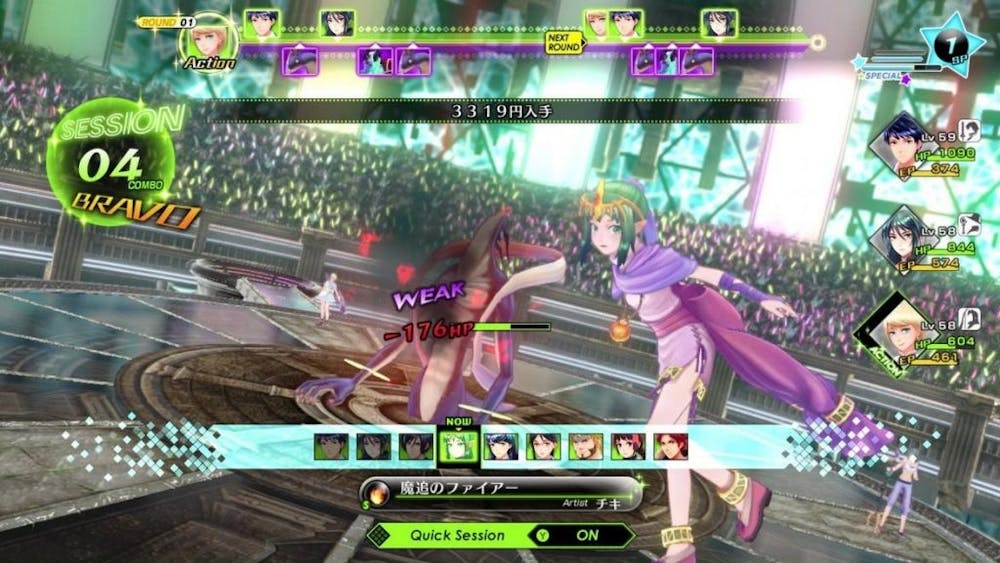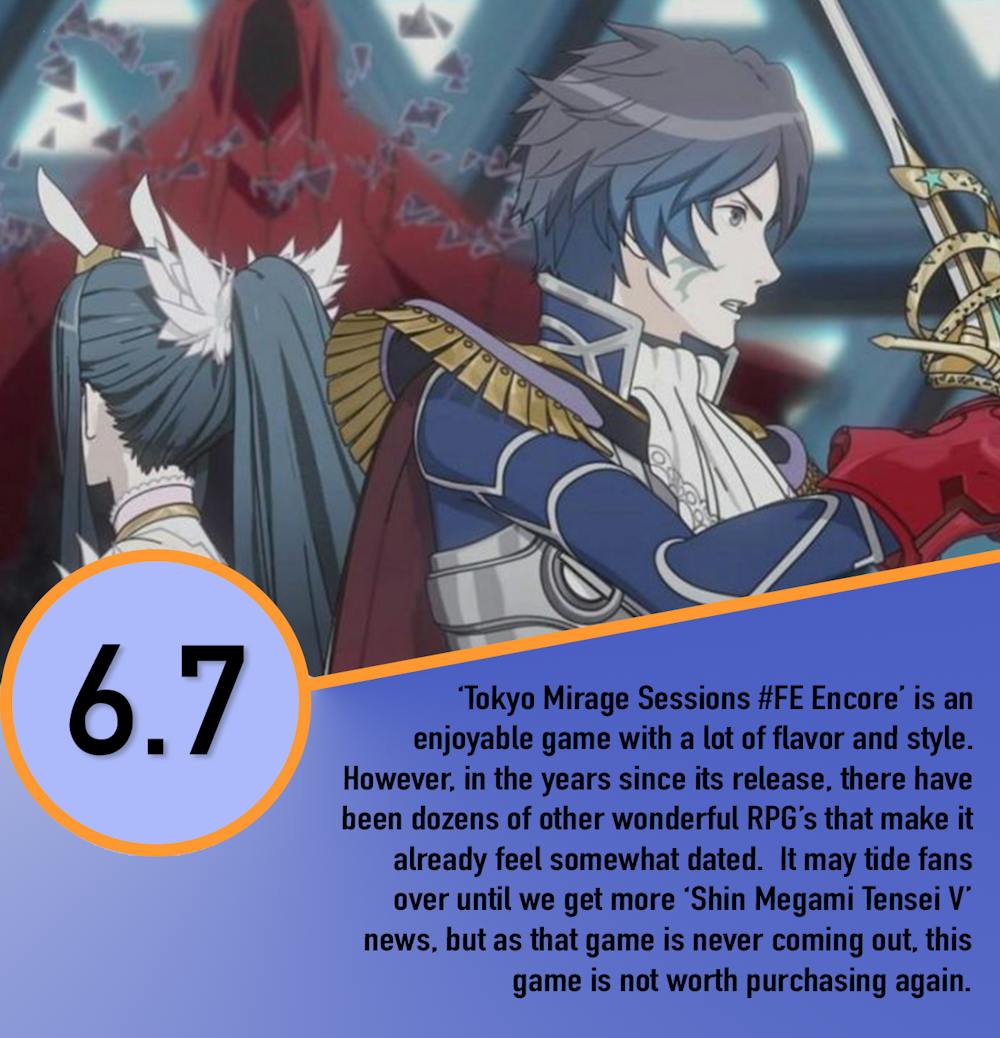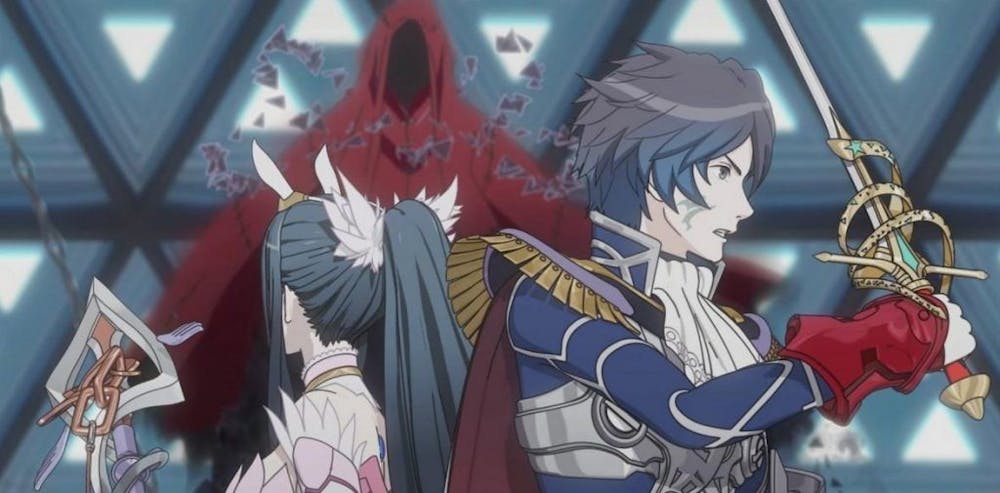It’s often tough judging Wii U games, particularly ones released toward the latter end of the console’s life. These titles, despite relative critical acclaim, were ultimately left in the dust. Titles like Xenoblade Chronicles X are genuinely wonderful and make great use of the Wii U’s gimmicks, particularly its bulky-but-comfy Gamepad, but being on the Wii U is both a blessing and a curse. A good Wii U game is a rare breed, considering how few great games were released for the console. So, there’s always the chance that a mediocre title on this system looks better because options are so limited. As a big fan of RPGs (Role-playing games), the Wii U was lacking in some of the better RPGs that released during its lifetime. But it did have Tokyo Mirage Sessions #FE, a game released by Atlus in the final year of the Wii U. I remember fondly finishing the game twice; it was a wonderful time and one of my favorite Wii U games.
In the Nintendo Switch rerelease, Tokyo Mirage Sessions #FE Encore, the game has hardly changed, which in itself isn’t such a bad thing. In a market full of incredible JRPGs, though, this isn’t a game I’m going to have on replay.
The same old “save the world” song and dance
Tokyo Mirage Sessions #FE Encore follows a trio of high schoolers: Itsuki, Tsubasa, and Touma, as they are thrust into combat against deadly supernatural forces and, even more dangerously, the Japanese entertainment industry. Although Touma is already a stunt man, Itsuki and Tsubasa are newbies at Fortuna Entertainment after getting scouted for their talents in combat and performance, which go hand-in-hand in this world. Over the course of their adventures, they team up with more performers to try and solve the mystery behind the Mirage incidents in Tokyo.

Image from Gamestop
But to take down Mirages, they team up with Mirages. This is where the first main crossover comes into play: your party has beloved Fire Emblem characters as partners and Stands/Personas. Each character has traces of their original personality, and interacts directly with the cast during various scenes in the game. However, they are fairly shallow in their depiction, boiled down to the bare essentials of their characters that are already flimsy to begin with. The most personality comes from Draug and Tharja, but the rest of the Fire Emblem representatives that aren’t villains feel underwritten. The villains from Fire Emblem are a bit more interesting and creatively written, but they don’t stick around for long enough to make much of an impression.
The writing overall is incredibly bland and sterile. Compared to other recent RPGs that have been tackling deeper social and political issues, Tokyo Mirage Sessions has a very cheesy “save-the-world” story without much in the way of variety and depth. There aren’t any crazy twists and turns, and it often just feels like a rehashing of similar beats from Persona 4. For a setting that has as much potential commentary as a game about the entertainment industry, Atlus definitely plays it safe here. The overarching narrative just doesn’t keep a player engaged in the world.
The story outside of the main narrative deals primarily in the personal growth of the cast as performers, particularly Tsubasa. There are a number of side stories that follow the cast as they take on new jobs and work to improve themselves in a cutthroat industry (not that the cutthroat nature is ever shown; the cast succeeds in everything they do and gets inexplicably popular). To their credit, the characters are all fairly likeable, even if they aren’t as complex as what you’d see in Atlus’s other main titles. Touma is probably my favorite character in the game, mostly because he’s the only one that actually fulfills the “zero-to-hero” narrative that makes the characters fun to root for. The side characters of Maiko, Barry Goodman, and Tiki also have some engaging backstories and character growth, but they could’ve definitely used some new content in the rerelease.
As for the rerelease’s new content, the most it does for the story is establishes that Tsubasa and Kiria are super in love with Itsuki, which was already blatantly obvious. However, watching them develop as equals instead of Tsubasa being a permanent fangirl was a nice touch. I just wish they had given more screen time to other characters.
Sleek, stylish, popping presentation
The presentation is easily the best and most consistent part of the game. The visuals are still beautiful eye-candy. The characters are distinct and colorful, and the world itself uses bright, poppy silhouettes instead of the traditional black silhouettes that you’d see. The dungeons all have their own unique aesthetic, much like the palaces in Persona 5. They don’t really represent the bosses you’ll fight, but there’s likely some sort of cultural significance that just doesn’t translate well. The animation during the song sequences is incredibly well-done too, featuring a good mix of 2D and 3D styles. The lip-sync during the fully 3D versions of these songs isn’t great, but it’s easy to ignore since many of these segments are fairly short. Animations during battle are also fairly elaborate, which can be both a good and bad thing in terms of the speed of fights. The newly added costumes are also a welcome addition for longtime fans of both franchises, and fit in perfectly during combat. In fact, Itsuki dressed up as Joker fits a little too well at times.

Image from Gamestop
The music is consistently great, which is unsurprising for a game about the music and entertainment industry. There are a ton of unique musical styles that are explored through the various dungeons, pop tracks, and battle themes. The different types of boss fights have appropriate music to fit the scenario, and can really make some moments especially powerful. The best moment in the game happens during Touma’s third side story, which uses the corrupted Mirage battle music flawlessly within its narrative to create something that really leaves an impact. The pop songs are also bangers in their own rights, with Yashiro’s song “Black Rain” being a personal favorite of mine, particularly the instrumental version.
Disappointingly, the rerelease only seems to have added a couple new mixes of previous songs and a new duet song for Kiria and Tsubasa. I would’ve liked to see some music for the underrepresented cast members (especially since Kiria and Tsubasa are the least interesting characters in the game,) but I understand why Atlus did it. This is borderline a waifu game, minus the dating sim aspect since Itsuki radiates absolutely no sexual energy.
Gameplay that has been relegated to an opening act
Tokyo Mirage Sessions’ biggest claim to fame is for being a crossover between Shin Megami Tensei and Fire Emblem. More accurately, Tokyo Mirage Sessions #FE is a crossover of Persona and Fire Emblem, with the latter game being more of a backup dancer than a leading act. Nearly every aspect of the game is lifted from the Persona series, minus some character names, the weapon triangle, and certain character/enemy classes. The rest of the game is one part turn-based RPG, designed around exploiting elemental weaknesses for extra combos and damage, one part dungeon exploration of larger-than-life locals, which is loosely tied to different parts of the entertainment industry (one Idolasphere is a TV studio gone mad, one is a photo shoot come to life, etc). Along with this, side stories follow your main character interacting directly with their party members and building personal relationships a la social links, except less interesting and with with less worthwhile rewards to gain.
The dungeons, named Idolaspheres, while visually very interesting, have puzzles that range from “mildly inconvenient” to “pointless busywork.” Not a single one of the dungeon puzzles really feels engaging to solve, and they aren’t particularly challenging either. The best puzzle comes in the form of Daiba Studio’s LCD panels, but it requires a lot of running back and forth that becomes tedious after enough time. Other than subpar puzzles, the pacing within dungeons is often broken up due to having to make trips back to craft new weapons and fulfill story requirements. The lack of a run button through these dungeons is something you wouldn’t think you’d miss–until your fourth trip through the same group of corridors.

Image from Gamestop
The combat itself is heavily inspired by Shin Megami Tensei and its spin-off Persona. The party of characters have their own Mirage, based on a Fire Emblem class. New skills, passives, and Session abilities can be unlocked through crafting weapons with materials gained from beating the snot out of enemies in the Idolaspheres. These classes can also rank up later in the game using a Master Seal, which mostly just ends up with flat stat bonuses and some specialized weapon types to allow a bit of customization. The customization aspect of these characters is actually fairly varied, since each character has stuff that they inherently prioritize (a weapon and an element), but also extra elemental skills, buffs, and debuffs that allow them to fill a unique role in combat. It allows for a lot of variety in how you build your party members and makes playing through the game again to experiment with some different party compositions and styles very satisfying.
Cracking into the combat, it’s a turn-based RPG, with turn-order being a constant thing the players can monitor and even affect using certain abilities. Like Shin Megami Tensei, the player has to use elemental/weapon advantages to swiftly dispatch enemies. However, unlike the more recent Shin Megami Tensei games, it uses a system similar to a follow-up attack from Strange Journey, with the other cast members jumping in using their own attacks in a combo chain, called Sessions. However, this combat really only shines during boss fights, as regular fights tend to just be fodder for your party to grind money and resources off of. During boss fights, planning proper strategy around set enemy patterns can create some real close fights, even if the rest of the game isn’t too challenging.
The problem is that Sessions are fairly slow and enemies can have an absurd amount of health, especially on higher difficulties. Even the easiest bosses you can be wailing on for a long time, and that’s with proper management of buffs and debuffs to maximize damage. The Quick Session feature helps speed things along, but it still makes one turn take way longer than it would in a regular Shin Megami Tensei game. Granted, it’s hard to beat the Press-Turn or Once More systems in creating fast-paced, strategic turn-based combat, but the lack of it in this game definitely makes it feel like a slog at parts.
TMS: Map of the Mediocre

Image from Gamestop
Playing through the rerelease made me realize something that really accentuates the slowness and other problems, which is that, in hindsight, the game really just feels like a prototype for Persona 5. The Idolaspheres are very similar to Palaces, minus the story impact and creativity in relating the Palaces to the bosses. The combat has a similar stylish flair, minus the wonderful incorporation of UI and Once More to make things flow perfectly. The characters even at times feel like underdeveloped party members for a Persona title. While this game certainly isn’t bad, there are definitely better titles on the Switch, and this rerelease didn’t do enough to help improve the experience. While not really a condemnation of the game in a vacuum, it just doesn’t stack up as well in the Nintendo Switch’s much more robust library.

Images: Gamestop
Featured Image: Gamestop
For more entertainment related content, visit us at Byte BSU!




















